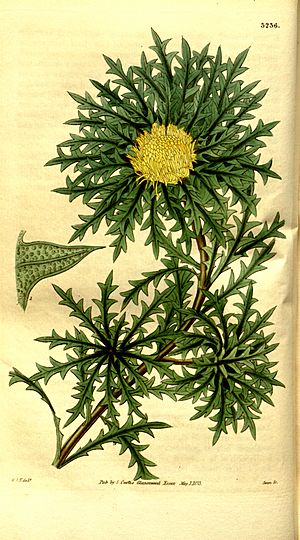Dryandra ser. Armatae facts for kids

Dryandra ser. Armatae was a special group of plants within the old Dryandra genus. Think of it like a specific family or section within a larger plant group. Today, the Dryandra genus is no longer separate. All its plants are now part of the Banksia genus, specifically in a group called Banksia ser. Dryandra.
This particular group, Dryandra ser. Armatae, was first named by a scientist named George Bentham in 1870. Later, in 1996, another scientist, Alex George, changed how this group was defined. However, in 2007, two scientists, Austin Mast and Kevin Thiele, decided that Dryandra plants should all be moved into the Banksia genus. Because of this big change, the old Dryandra ser. Armatae group is no longer used in plant classification.
How George Bentham Saw It
George Bentham was one of the first botanists to describe and group these plants. In 1870, he created the Dryandra ser. Armatae group. He described the plants in this group as having:
- Large flower heads, usually at the top of the plant.
- Flower heads surrounded by leaves that were longer than the flowers.
- Leaves with sharp, prickly teeth or lobes.
Bentham included several species in his Armatae group. For example, some plants he placed here were Dryandra armata (now called Banksia armata) and Dryandra longifolia (now known as Banksia prolata).
How Alex George Saw It
Bentham's way of grouping these plants stayed the same for a long time. Then, in 1996, Alex George published his own updated classification of Dryandra plants. George changed the definition of Dryandra ser. Armatae. His new group was much larger, including 20 different species. Only a few of the plants Bentham had included were still in George's version of Armatae.
The plants in George's Armatae group were mostly upright shrubs. They often had big, bright yellow flower heads. Their seed pods, called follicles, were easy to detach. Also, their seeds had a special notched wing.
Some of the plants George included in his Armatae group were:
- Dryandra cuneata (now Banksia obovata)
- Dryandra armata (now Banksia armata)
- Dryandra longifolia (now Banksia prolata)
- Dryandra polycephala (now Banksia polycephala)
What Happened Recently
Since 1998, a scientist named Austin Mast has been studying the DNA of these plants. His research showed that the Dryandra genus actually grew out of the Banksia genus. This means that Banksia was not a complete group without including Dryandra.
Because of this strong evidence, in 2007, Mast and Kevin Thiele decided to combine Dryandra into Banksia. All Dryandra plants are now considered part of Banksia ser. Dryandra. This big change meant that Alex George's old way of grouping Dryandra plants, including Dryandra ser. Armatae, is no longer used. Scientists are still working on a full new classification for all these plants based on their DNA.

